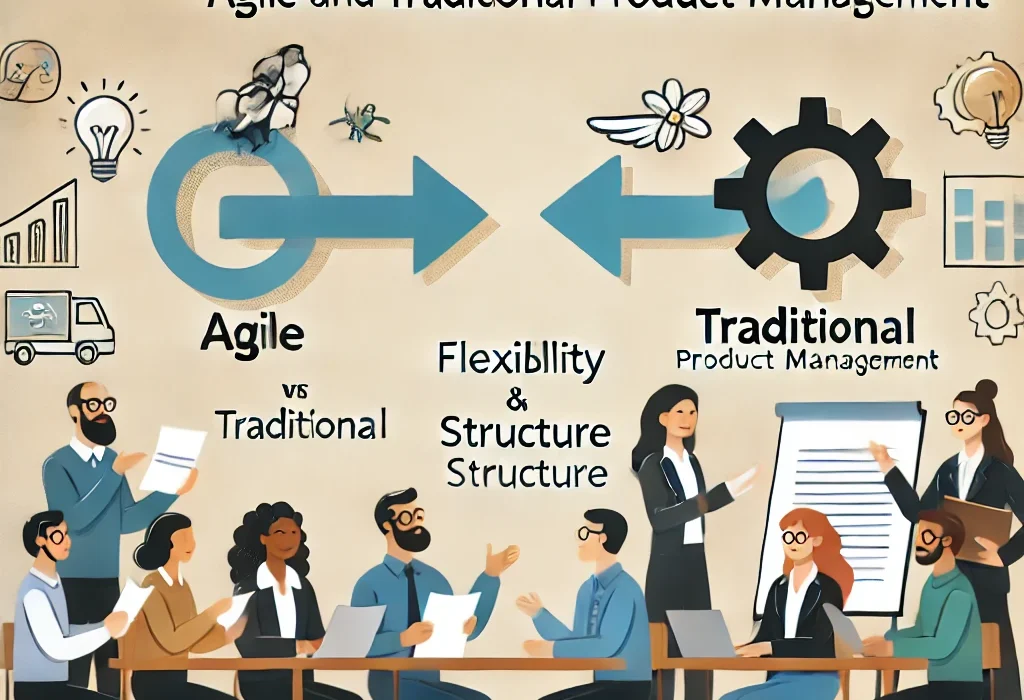
Table of Contents
ToggleIntroduction: How is Agile Product Management Different from Traditional Methods?
Product management is the backbone of turning great ideas into real, tangible products. It’s all about making sure the vision aligns with customer needs and market demands. But how a product manager approaches the journey from concept to launch can vary greatly. Two of the most common approaches are Agile Product Management and Traditional Product Management.
If you’re involved in developing or managing products, you’ve probably heard the buzz around Agile. It’s been embraced by tech companies, startups, and even larger corporations that want to move fast and stay flexible. But what exactly sets Agile apart from more traditional, linear methods like the Waterfall approach? And why does this difference matter?
In this article, we’ll explore what makes Agile product management stand out, how it contrasts with traditional methods, and why companies are increasingly making the switch to Agile frameworks. Whether you’re a beginner product manager, experienced pm, developer, or just someone curious about how products come to life, understanding these differences can help you navigate the changing landscape of product management.
Agile, at its core, is about adapting quickly to change. It allows teams to respond to feedback, iterate on ideas, and keep the customer at the center of everything. On the flip side, traditional product management often involves careful upfront planning, strict timelines, and less flexibility for unexpected changes. There’s no one-size-fits-all answer, and both methods have their place but understanding when and why to use each is key.
Next, we’ll dive into what Agile product management really looks like in practice, and why it’s taken the world of product development by storm.

What is Agile Product Management?
Agile product management is a dynamic approach that focuses on flexibility, collaboration, and incremental progress. Unlike traditional methods, which rely on rigid plans and detailed upfront requirements, Agile embraces the idea that product development is inherently unpredictable. It’s a methodology that’s particularly useful in today’s fast-paced world, where market conditions can change overnight and customer feedback flows in constantly.
At its heart, Agile product management works through iterative cycles, often called sprints. These short bursts of development, typically lasting 2-4 weeks, allow teams to focus on specific features or improvements. Once a sprint is completed, the team reviews the work, gathers feedback from stakeholders and customers, and adjusts their approach for the next sprint. This ongoing feedback loop helps ensure that the product evolves in a way that meets user needs more accurately and rapidly.
The most common Agile framework used in product management is Scrum. Scrum defines roles like the Product Owner, Scrum Master, and the Development Team, each of whom plays a key part in keeping the process organized and efficient. The Product Owner in Agile product management is somewhat akin to a traditional product manager, but with a much greater emphasis on constant customer interaction and prioritizing work that delivers the most value.
One of the key reasons Agile has become so popular is its ability to adapt to change. Instead of committing to long-term plans that may become obsolete, Agile allows teams to pivot based on new information, whether that’s shifting customer preferences or technological advancements. It’s designed to be responsive, making it easier to course-correct and avoid the pitfall of delivering a product that no longer aligns with market needs.
Agile is not just about speed—it’s about focus. Teams work on smaller, more manageable tasks in each sprint, which helps keep the development process aligned with user feedback and business goals. Instead of overwhelming the team with a giant project, Agile breaks it down into bite-sized pieces. This makes it easier to track progress and spot potential issues early on.
In Agile, the product backlog is another crucial tool. This is essentially a prioritized list of features, bug fixes, or improvements the team plans to address. The Product Owner constantly updates this list based on feedback, market conditions, and business priorities. Unlike in traditional methods, where the project plan is fixed, the backlog is flexible, allowing the team to tackle the most important tasks first.
With Agile, product management becomes an ongoing conversation. Product managers collaborate closely with designers, developers, and customers, continuously refining the product. This is a stark contrast to traditional approaches, where much of the planning happens in isolation at the start of the project.
To summarize, Agile product management is about embracing change, working iteratively, and keeping the customer at the center of the development process. It’s a fluid, collaborative approach that allows teams to stay flexible and deliver value faster.
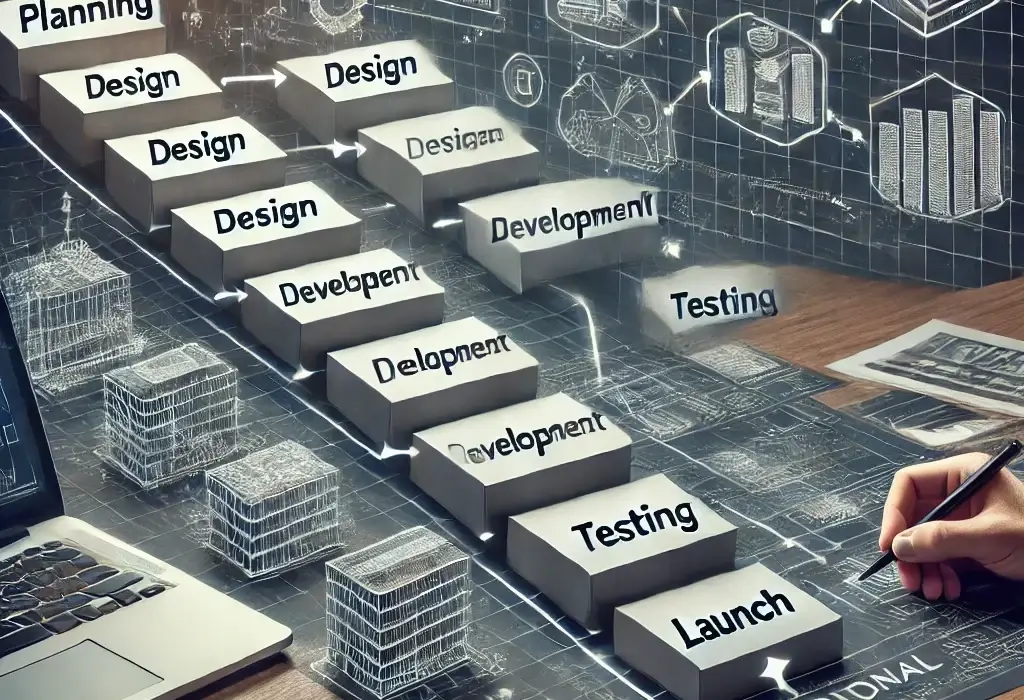
What is Traditional Product Management?
Traditional product management, often associated with the Waterfall methodology, is the old-school approach to product development. Unlike Agile, where the process is fluid and adaptive, traditional product management follows a more linear, structured path. The name Waterfall itself gives you a sense of the method, each phase flows into the next, and once you complete one stage, it’s hard to go back. In traditional methods, you aim to lock down all the details upfront and follow a clear, sequential process from start to finish.
The Waterfall methodology is divided into several distinct phases: planning, design, development, testing, and deployment. Each phase has specific deliverables that must be completed before moving to the next step. For example, during the planning phase, the product manager works closely with stakeholders to define the product’s requirements. Once this is done, the team moves into the design phase, where they create detailed plans for how the product will look and function. After that comes the development phase, where engineers build the product based on those detailed specifications.
One of the defining characteristics of traditional product management is its predictability. Because the process is so well-defined, it’s easier to create a project timeline with clear milestones and deadlines. This level of certainty is attractive in industries where strict regulations or safety requirements demand careful upfront planning. For instance, industries like aerospace, healthcare, or large-scale manufacturing tend to prefer traditional methods, where changes mid-project can be costly and potentially dangerous.
In a traditional model, the role of the product manager is focused heavily on upfront work, gathering requirements, setting timelines, and ensuring all stakeholders are aligned before the development begins. Once the plan is set, the product manager acts more as an overseer, ensuring that each phase progresses according to the established schedule. Customer feedback typically isn’t integrated until the testing phase or even after the product has been launched, which can be a major downside if market conditions or customer needs shift during the lengthy development process.
One of the key aspects of traditional product management is its emphasis on documentation. Every requirement, design choice, and task must be thoroughly documented before development begins. This extensive documentation helps reduce ambiguity and keeps everyone on the same page, but it also introduces a layer of rigidity. If something changes halfway through the project, making adjustments can be time-consuming and complicated, often requiring a full revision of the original plan.
While traditional product management works well for projects that are highly predictable and stable, it can become a liability when dealing with fast-changing environments. Imagine working on a product for 12 months based on initial assumptions, only to realize at the end of the process that the market has shifted, or the customer’s needs have evolved. In this scenario, the lack of flexibility in the traditional method can lead to wasted time, money, and effort.
That said, traditional methods still have their place in industries where precision and predictability are non-negotiable. In these cases, the Waterfall approach offers a clear structure that mitigates risks by focusing on detailed upfront planning. However, in industries where innovation and rapid iteration are critical, traditional methods often struggle to keep pace with changing demands.
In summary, traditional product management is a highly structured, phase-driven approach that works well in stable, predictable environments. It offers clarity and control but lacks the flexibility of Agile when it comes to adapting to new information or changing market conditions.
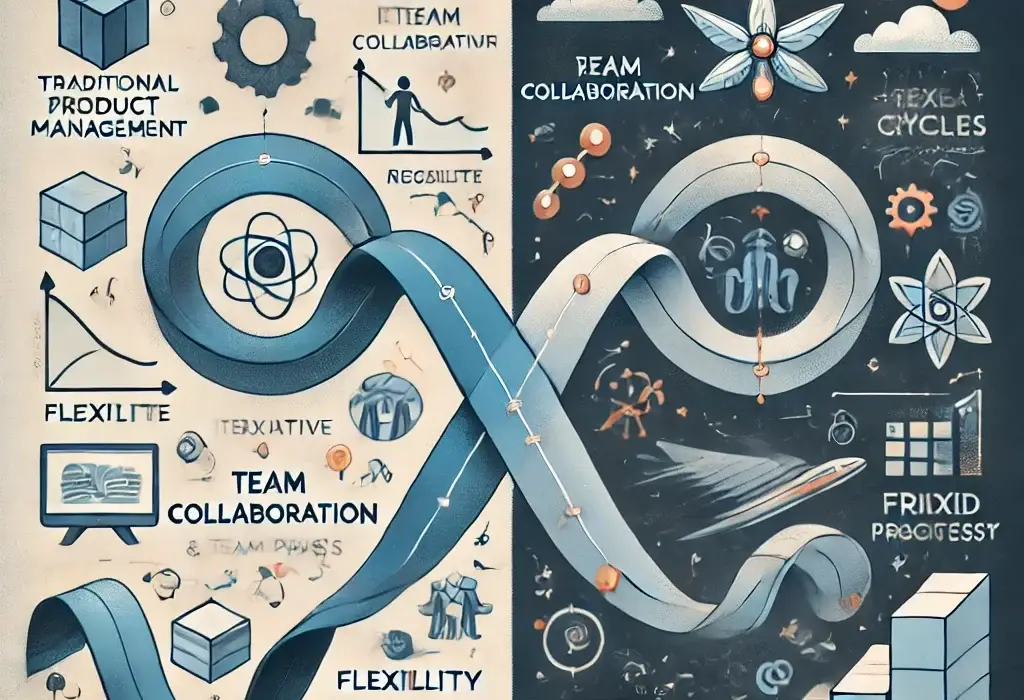
Key Differences Between Agile and Traditional Product Management
Now that we’ve explored both Agile and Traditional product management approaches, let’s dive into the key differences between the two. Understanding these differences can help you decide which method is best suited for your project or organization.
1. Flexibility vs. Rigidity
One of the most striking differences between Agile and traditional product management is the level of flexibility.
- Agile is highly adaptable. It thrives on change and encourages teams to modify their course based on feedback or new developments. Because Agile operates in short, iterative cycles (like sprints), there’s constant room for adjusting priorities or shifting focus based on new information. This flexibility allows teams to respond quickly to customer feedback, market shifts, or unforeseen challenges.
• Traditional product management, on the other hand, is far more rigid. It follows a linear, phase-based structure, where each step is planned in detail before moving on to the next. Once the requirements are set and the project has moved to the design or development phase, making changes is costly and time-consuming. This rigidity can be a disadvantage if the project encounters unexpected changes along the way.
2. Customer Involvement
Customer feedback plays a vastly different role in Agile and traditional methods.
- In Agile product management, customer input is integral throughout the entire development process. Teams actively seek feedback after each sprint, allowing them to refine features, fix issues, and prioritize the next steps based on real-world input. This constant interaction helps ensure the product is aligned with customer expectations and market needs from start to finish.
• In traditional product management, customer feedback typically comes in much later, often during the testing phase or even post-launch. This delayed involvement means that any feedback requiring changes may be difficult or even impossible to implement without significant delays or costs. The lack of ongoing customer interaction increases the risk of the product being misaligned with user needs by the time it’s completed.
3. Timeframes: Sprints vs. Long-Term Timelines
The way time is managed in Agile versus traditional methods couldn’t be more different.
- Agile breaks down the project into short sprints, usually lasting 2-4 weeks. After each sprint, the team assesses progress, gathers feedback, and adjusts for the next iteration. This cycle repeats, with small, incremental product updates being delivered regularly. This short-term focus allows teams to build a product piece by piece and make frequent course corrections if needed.
• In traditional product management, the focus is on long-term planning. The entire project is mapped out at the beginning, with detailed timelines that span the entire lifecycle. Progress is measured by milestones, but the bulk of the product isn’t delivered until the end of the process. While this allows for careful, deliberate planning, it also means that unexpected delays or changes can have a ripple effect, pushing out deadlines and causing frustration for stakeholders.
4. Decision-Making and Collaboration
Agile and traditional product management also differ in how decisions are made and how teams collaborate.
- Agile encourages a collaborative, cross-functional approach where everyone’s input is valued. Decisions are often made collectively, with team members—including developers, designers, and stakeholders—working closely together throughout the process. The Product Owner plays a central role in prioritizing tasks, but feedback from the team and customers heavily influences what gets done.
• In traditional product management, decision-making is more top-down. The product manager typically works with executives or stakeholders to establish the product’s goals, then hands off the detailed plan to the development team to execute. The focus is less on collaboration and more on adhering to the established project plan. Teams may work in silos, with less communication between departments until specific handoff points.
5. Handling of Risk and Feedback Loops
Agile and traditional methods approach risk and feedback in fundamentally different ways.
- In Agile, risks are mitigated by the constant feedback loop. Every sprint offers an opportunity to address issues, gather insights, and make improvements. This iterative approach means that risks are identified and dealt with early, reducing the likelihood of major problems later in the project.
• Traditional product management takes a more upfront risk management approach. The idea is to plan as much as possible in the early phases to avoid issues later on. However, because feedback isn’t integrated until the end stages, there’s a greater risk that problems will go unnoticed until it’s too late to fix them without costly rework.
6. Project Ownership and Focus on Value
Ownership and focus differ significantly between the two methods.
- In Agile, there’s a strong emphasis on delivering value incrementally. Teams are focused on completing smaller features that provide immediate value to the customer, rather than waiting until the entire product is ready. Ownership of the project is shared among team members, and the process is driven by collaboration and continuous improvement.
- Traditional methods emphasize delivering the whole product as a final deliverable, rather than focusing on incremental value. The product manager typically owns the entire process and is responsible for ensuring that the product is built according to the predefined plan, but there’s less flexibility in adjusting scope or features along the way.
These fundamental differences in flexibility, customer involvement, timelines, collaboration, and risk management highlight why Agile product management has become so popular in modern industries where adaptability is key. Traditional methods, while still effective in certain situations, often struggle to keep up with the fast-paced demands of today’s markets.
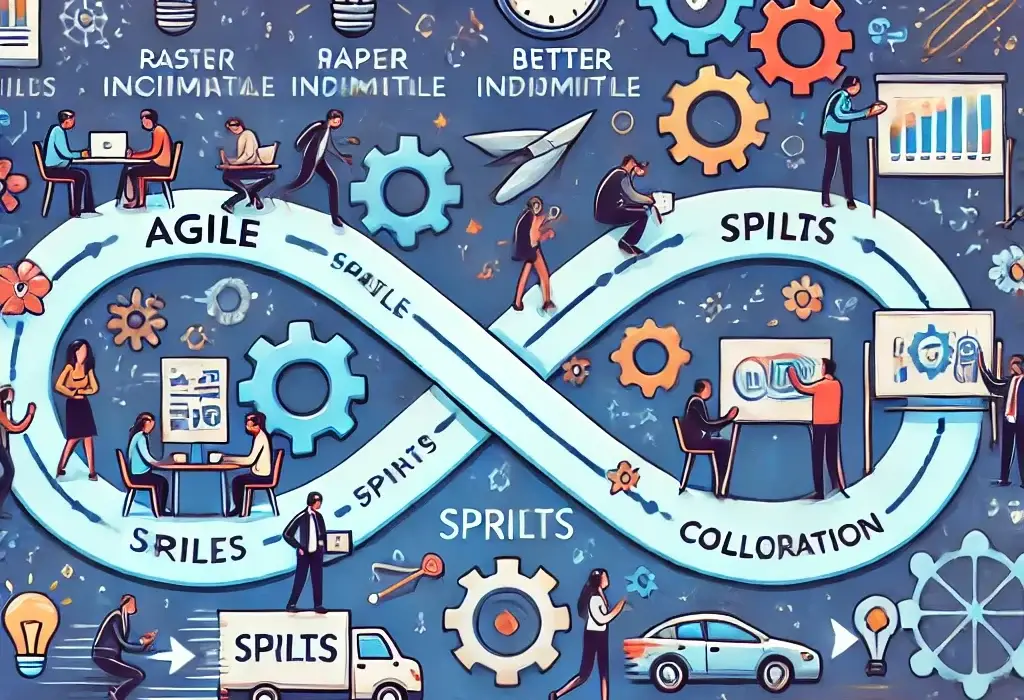
Benefits of Agile Product Management Over Traditional Methods
Agile product management has gained popularity for a reason: it offers clear advantages over traditional methods, especially in environments where speed, flexibility, and customer satisfaction are key. Let’s explore the specific benefits of adopting Agile over traditional product management.
1. Faster Product Iterations
One of the most significant advantages of Agile is its ability to deliver faster product iterations. Agile teams work in short sprints, each lasting just a few weeks. This means that they can develop, test, and release features or product updates far more frequently than with traditional methods, which often involve long timelines and large, monolithic releases.
For example, in Agile, a team might release a minimum viable product (MVP) after just a few sprints, allowing them to test core functionality with real users early in the development process. This early feedback allows for continuous improvement, whereas traditional methods might require months or even years of development before users get their hands on the product.
2. Better Adaptability to Market Changes
In fast-moving industries, agility is essential. Agile product management allows teams to respond quickly to changing market conditions, new customer demands, or emerging competitors. Because Agile operates in short cycles, the product roadmap can be adjusted frequently without derailing the entire project.
In contrast, traditional methods tend to be less flexible. Once a detailed plan is set and development begins, any changes can lead to costly reworks or missed deadlines. Agile’s iterative approach allows for a more fluid response to changes, ensuring that the product remains relevant as the market evolves.
3. Increased Customer Collaboration
A significant benefit of Agile is the constant feedback loop with customers. Agile teams actively seek input from customers or stakeholders after every sprint, ensuring that the product is always being shaped by real-world feedback. This continuous collaboration helps to prevent the development of features or products that don’t meet the needs of users.
In contrast, traditional methods often involve gathering customer requirements at the start of the project and then revisiting them only at the end. This gap in communication can lead to a product that no longer aligns with customer expectations by the time it’s delivered.
Agile’s focus on collaboration helps ensure that the final product is aligned with customer needs and provides tangible value. By incorporating feedback at every stage, Agile product managers can prioritize features that truly matter to users, rather than relying on assumptions made at the outset.
4. Focus on Delivering Value Incrementally
In Agile, the focus is on delivering value continuously, rather than waiting until the end of a long project cycle to release a product. Each sprint results in a potentially shippable product increment, meaning that customers or stakeholders can see progress early and often.
This is a big advantage over traditional methods, where the entire product is usually delivered only once it’s fully developed. By the time a traditional product is ready for release, market conditions or customer needs may have shifted, reducing the product’s value. With Agile, there’s always something to show, test, and improve upon, keeping the product development aligned with both business goals and customer expectations.
5. Reduced Risk Through Early Feedback
Because Agile teams release working software at the end of every sprint, they can identify risks and issues early in the process. Whether it’s a technical problem, a misalignment with customer expectations, or a feature that isn’t performing as anticipated, Agile allows teams to address these issues incrementally, rather than discovering them all at once at the end of a long development cycle.
Traditional product management, with its focus on big, end-stage releases, doesn’t offer this kind of early risk detection. By the time testing and customer feedback roll in, fixing issues can be time-consuming and expensive. Agile’s iterative approach minimizes this risk, as problems can be caught early, allowing teams to adjust course before they become major obstacles.
6. Improved Team Morale and Collaboration
Agile encourages close-knit, cross-functional collaboration. In Agile teams, developers, designers, product managers, and other stakeholders work side by side, which fosters better communication and teamwork. This contrasts with traditional methods, where different teams often work in silos and only interact during certain phases of the project.
The Agile framework also empowers teams by giving them ownership of their work. They have a say in how much work they take on during each sprint and how they approach problems. This sense of autonomy can lead to higher job satisfaction and increased team morale.
In contrast, traditional models often involve top-down management, where decisions are made by higher-ups and passed down to the development team. This can lead to disengagement if team members don’t feel a sense of ownership or if they disagree with the direction of the project but aren’t in a position to change it.
7. Faster Time to Market
With Agile, teams can release small updates or new features frequently, leading to a faster time to market overall. By delivering smaller, incremental improvements, Agile teams can keep the product competitive and relevant without waiting for a large, all-encompassing release.
In contrast, traditional product management methods require a long development cycle, and if any delays occur, they can push back the entire launch. For industries where speed is crucial—such as technology or e-commerce—this slow pace can lead to missed opportunities. Agile’s faster release cycles help companies stay ahead of their competition and respond to customer needs in real-time.
Overall, Agile product management offers a more flexible, customer-focused, and iterative approach that can greatly enhance the speed and quality of product development. Its ability to adapt quickly to changes, deliver frequent value, and foster better collaboration sets it apart from traditional methods, particularly in industries where innovation and speed are critical to success.

Challenges of Implementing Agile in Product Management
While Agile product management offers a wealth of benefits, it’s not without its challenges. Transitioning from traditional product management to Agile can be a complex process, and even seasoned Agile teams can face hurdles in implementing and maintaining the framework. Let’s explore some of the common challenges of adopting Agile in product management and how to navigate them.
1. Difficulty in Transitioning from Traditional Models
One of the biggest hurdles for organizations trying to adopt Agile is cultural resistance to change. Many teams and companies are deeply ingrained in traditional processes like Waterfall, where long-term planning and detailed documentation are central to how work gets done. Shifting from this mindset to the more flexible, iterative nature of Agile can feel disorienting for teams used to having every detail mapped out from the start.
In some cases, management may be hesitant to embrace Agile because it can appear more chaotic or less predictable than traditional methods. Leaders may worry that the lack of a detailed, long-term plan could lead to scope creep or projects going off the rails. Changing organizational culture to support Agile often requires a top-down commitment, with leaders fully embracing Agile principles and educating the entire team on the benefits of a more iterative approach.
To ease the transition, companies may need to invest in Agile coaching or training programs to help teams understand the principles behind Agile and how to implement them effectively. It’s also essential to start small perhaps by piloting Agile on a single project before scaling the framework across the organization.
2. Maintaining a Consistent Agile Mindset
Even after making the switch to Agile, maintaining a true Agile mindset can be challenging. It’s easy to fall back into traditional habits like over-planning or trying to force fixed deadlines into a process that’s meant to be flexible. Agile’s success depends on teams embracing the idea that change is constant, and plans will evolve over time.
Some organizations claim to be Agile but only adopt the surface-level practices, like running sprints or holding daily stand-ups, without fully committing to the underlying principles. This can lead to a watered-down version of Agile that doesn’t yield the same benefits. For Agile to truly work, teams need to internalize values like collaboration, continuous improvement, and customer-focused development. Staying true to these principles, even when facing pressure to meet deadlines or deliver results, is key to maintaining a successful Agile environment.
3. Balancing Agile Principles with Company Constraints
Not every organization is structured in a way that easily supports Agile principles. In large, established companies with well-defined hierarchies and processes, Agile can feel at odds with existing workflows. For example, in heavily regulated industries like finance or healthcare, there may be strict compliance requirements that require detailed documentation, making it difficult to embrace Agile’s lighter approach to planning and documentation.
In such cases, teams may need to find a balance between Agile practices and organizational constraints. This could involve adopting a hybrid approach, where some Agile methods (like sprints and iterative development) are used, but other traditional elements (like documentation or phased approvals) remain in place to meet regulatory requirements. The key is to stay flexible and tailor Agile principles to fit within the specific needs and limitations of the organization, rather than adopting a one-size-fits-all approach.
4. Agile Requires Strong Leadership and Buy-In
Agile product management relies heavily on empowered teams and strong leadership. Without the right support from management, Agile can falter. Leaders need to trust their teams to make decisions and adapt quickly, which can be a difficult shift for those who are used to more top-down control. It’s also crucial for product managers and Scrum Masters to take on a strong leadership role, guiding the team through the Agile process, facilitating communication, and removing obstacles that could hinder progress.
Getting buy-in from the entire team is equally important. Agile works best when everyone, from developers to stakeholders, is committed to the process and understands its value. If there are members of the team who resist Agile practices or don’t fully understand them, it can lead to confusion, frustration, and even project delays. Regular training, open communication, and ensuring everyone understands the benefits of Agile can help address this challenge.
5. Managing Stakeholder Expectations
One of the trickiest aspects of Agile is managing expectations—especially with stakeholders who are used to traditional timelines, milestones, and deliverables. Agile’s iterative nature means that deliverables are provided in smaller, more frequent increments, which may not always align with a stakeholder’s expectations for fully completed features or products.
In a traditional setting, stakeholders might expect a finished product by a fixed deadline, but in Agile, they’ll see work in progress throughout the development process. This can cause friction if stakeholders don’t understand that Agile is focused on continuous improvement and delivering value gradually over time.
To mitigate this, Agile product managers need to set clear expectations with stakeholders early on. Explaining the Agile process, how feedback is integrated, and how the product will evolve incrementally can help stakeholders feel more comfortable with the process. Regular communication through sprint reviews or demos also helps keep everyone aligned and allows stakeholders to see progress without feeling left out.
6. Agile Isn’t Always a Perfect Fit
While Agile is incredibly powerful, it’s not the best approach for every situation. Some projects, especially those with fixed timelines, strict regulatory requirements, or well-defined scopes, might be better suited to traditional methods. For example, in industries like construction or manufacturing, where each step of the project is highly dependent on the previous one being completed, the linear nature of traditional methods might be more appropriate.
It’s essential to recognize that Agile is a tool, not a one-size-fits-all solution. There will be times when Agile works beautifully and times when it may be better to stick to more traditional approaches. Product managers need to evaluate the needs of each project individually and determine whether Agile, traditional, or a hybrid approach makes the most sense.
While Agile product management offers significant advantages, it’s important to understand the challenges that come with it. Successfully implementing Agile requires cultural buy-in, strong leadership, and the ability to adapt Agile principles to the specific needs of your team or organization. However, with the right preparation and mindset, many of these challenges can be overcome, making Agile a powerful tool for product development.
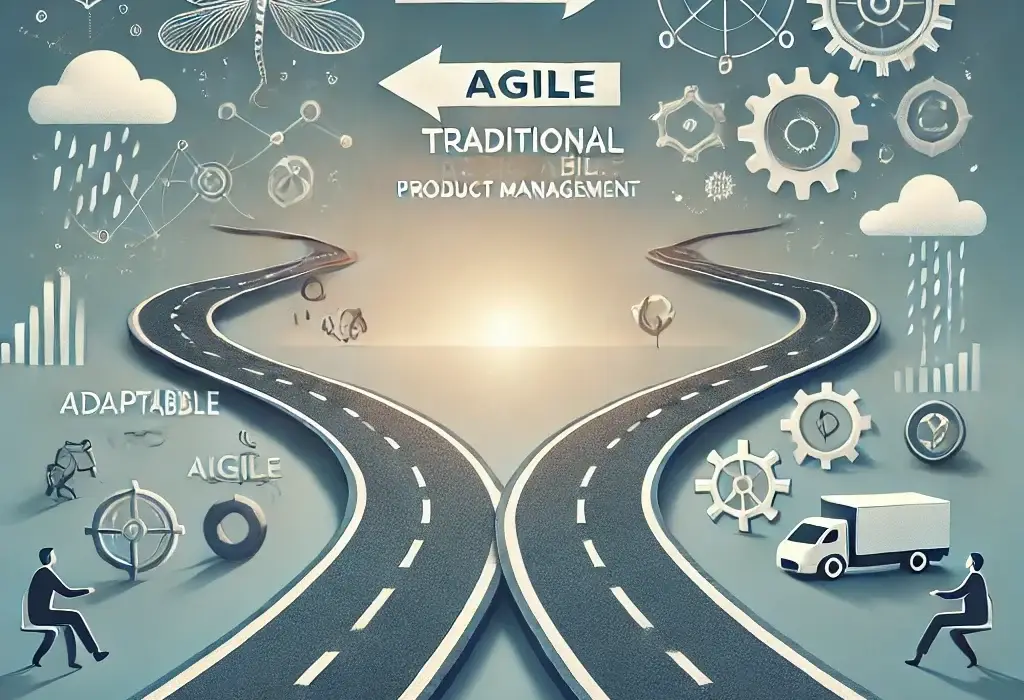
When to Use Agile vs. Traditional Product Management
Deciding whether to use Agile or Traditional product management depends on several factors, including the nature of the project, the industry, team dynamics, and customer needs. While Agile is incredibly versatile, there are certain scenarios where traditional methods may still be the better choice. Let’s explore when to use Agile, when to stick with traditional product management, and how hybrid approaches can provide the best of both worlds.
1. Use Agile When Flexibility and Iteration Are Critical
Agile is an ideal choice for projects where flexibility and frequent iteration are important. This is particularly true in industries that experience fast-paced changes or where customer feedback is critical to the success of the product.
For example, in software development, Agile shines. Software products often require constant updates, improvements, and feature additions based on user feedback. Agile’s short sprints allow developers to release new versions regularly, gathering insights from real users and adapting the product accordingly. In this context, the ability to pivot quickly and make incremental changes is invaluable.
Similarly, startups or businesses working on innovative projects often benefit from Agile. Startups typically operate with limited resources and face high levels of uncertainty. Agile allows them to validate their ideas quickly, reduce waste, and adjust based on market feedback. The focus on delivering a minimum viable product (MVP) early on, followed by iterative improvements, aligns perfectly with the needs of fast-moving startups.
2. Use Traditional Methods When Predictability is Key
On the other hand, traditional product management is better suited for projects where predictability, structure, and thorough upfront planning are necessary. This is especially true for projects with strict deadlines, limited room for change, or significant regulatory requirements.
Industries like construction, aerospace, or manufacturing often rely on the Waterfall method or other traditional models. In these industries, each phase of the project depends on the completion of the previous phase, and changes mid-project can be costly or dangerous. For example, in construction, changing the design halfway through a project could cause delays, increase costs, and lead to safety issues. Traditional methods offer a clear and structured approach, ensuring that each stage of the project is fully completed before moving on to the next.
Another case where traditional methods might be preferable is when there’s a well-defined scope with minimal expected changes. If the requirements are unlikely to change and the outcome is clear from the beginning, traditional product management’s linear approach can help ensure everything stays on track.
3. Use Agile When Customer Feedback is Ongoing
If your product requires ongoing customer feedback throughout development, Agile is the way to go. Products in fast-changing markets, like e-commerce or consumer tech, benefit greatly from Agile’s iterative development process. Customers in these industries often have rapidly evolving needs, and Agile allows teams to release small updates and adjustments in response to their feedback.
In Agile, the customer is deeply involved in the process, providing input after each sprint. This keeps the product aligned with customer expectations and helps ensure that each feature provides value. For example, in app development, user feedback might lead to the addition of new features or the tweaking of existing ones. Agile allows you to respond to these needs quickly, rather than waiting for a full release cycle.
4. Use Traditional Methods When You Have Clear Milestones and Long-Term Plans
Traditional product management is more suitable when a project has well-defined milestones and long-term objectives that are unlikely to change. Large projects that require extensive planning and coordination such as infrastructure projects or government contracts often benefit from traditional methods, where the clarity of a step-by-step approach is paramount.
In these cases, traditional methods help ensure that everyone is aligned on the end goal from the outset. Teams know exactly what needs to be done, by when, and how much it will cost. The predictability of Waterfall and other traditional methods ensures that each phase is completed according to plan, which can reduce risk in projects where changes are hard to accommodate.
5. When to Consider a Hybrid Approach
In many cases, a hybrid approach combining Agile and traditional methods may be the best solution. This is often referred to as Agile-Waterfall hybrid or Agile at scale. A hybrid approach allows teams to take advantage of the benefits of both methodologies, tailoring them to the specific needs of the project.
For example, a company might use Agile for its software development teams, allowing them to quickly iterate on product features, while applying traditional methods for the project’s hardware components, where changes need to be carefully planned in advance. This allows the company to respond to market feedback on the software side while ensuring stability and predictability on the hardware side.
Hybrid approaches are also common in large organizations where different departments operate under different constraints. For example, the IT department might use Agile to rapidly develop new tools and services, while the operations team follows a more traditional approach for logistical or compliance reasons. This flexibility allows businesses to remain agile where it matters most while maintaining structure in areas that require more control.
6. Industry Examples: Agile vs. Traditional
- Tech Startups: Startups often thrive with Agile because they need to move fast, test ideas quickly, and adapt to market feedback. In such fast-moving environments, waiting for a long project to be fully completed can be risky. Startups that release a quick MVP and then iterate based on real-world feedback are more likely to succeed.
- Healthcare: In healthcare, where regulations and compliance play a significant role, traditional methods are often preferred. Medical devices, for example, must undergo extensive testing, validation, and documentation to ensure safety and effectiveness. Agile can still play a role in certain phases (such as software development), but overall, traditional methods dominate because of the high stakes involved.
• Enterprise Software Development: Large software companies may employ a hybrid approach. Agile is used to develop customer-facing features quickly, while Waterfall might be employed for backend infrastructure updates that require precise scheduling and limited room for error.
7. Key Factors for Choosing Agile or Traditional
Ultimately, the choice between Agile and traditional methods comes down to a few key factors:
- Nature of the Project: Is the project open to change, or are the requirements fixed?
- Industry: Is the industry fast-paced and innovative, or heavily regulated with little room for error?
- Customer Needs: Do customers expect rapid updates and improvements, or are they more concerned with getting a finished product at a later stage?
- Team Dynamics: Is the team ready to embrace collaboration, iteration, and flexibility, or does it work better with a clear plan and fixed deadlines?
- Risk Tolerance: Is the project tolerant of change and the potential risks that come with experimentation, or is predictability essential?
In conclusion, there’s no definitive answer as to whether Agile or Traditional product management is better—it depends on the project’s needs, the industry, and the team’s ability to adapt. Agile excels in environments that are fast-paced, customer-driven, and open to change, while traditional methods provide stability and control in projects where predictability is paramount. Hybrid approaches allow teams to tailor the best of both worlds, adapting to the specific demands of each project.

Conclusion: Understanding the Difference Between Agile and Traditional Product Management
Both Agile and traditional product management offer distinct approaches to bringing products to life, and knowing when to apply each method is crucial for success. Agile product management is all about flexibility, collaboration, and continuous improvement. It’s ideal for fast-moving industries, startups, and projects that require constant iteration based on customer feedback. Agile’s adaptability makes it a powerful tool in environments where change is constant, and customer needs are always evolving.
On the other hand, traditional product management excels in situations where predictability, structure, and careful upfront planning are essential. Industries like construction, healthcare, and manufacturing often benefit from the step-by-step nature of traditional methods, which prioritize clear timelines and detailed documentation. When the project scope is well-defined, and the risks of change are high, traditional methods provide stability and control.
In many cases, organizations may find that a hybrid approach—one that combines elements of both Agile and traditional methods—works best. By adapting the right tool for the right situation, teams can benefit from Agile’s iterative flexibility while maintaining the structure and predictability needed for more rigid projects.
Ultimately, the key to successful product management lies in understanding the unique demands of each project and choosing the right methodology to meet those demands. Whether you’re working in a fast-paced tech environment or a more regulated industry, knowing the strengths and limitations of both Agile and traditional product management helps you navigate the complexities of development and deliver a product that truly meets your customers’ needs.
Additional Resources:
Scrum and Agile Roles:
- Scrum.org – Scrum Guide
- The official guide to Scrum, detailing the roles, events, and artifacts used in Agile product management.
Waterfall Methodology:
- Project Management Institute (PMI) – Waterfall Methodology
- An overview of the Waterfall methodology and its use cases from the globally recognized Project Management Institute.
Transitioning from Waterfall to Agile:
Insights from McKinsey on transitioning to Agile frameworks and why it’s important for modern organizations.
Hybrid Approaches in Product Management:
- Gartner – Balancing Agile and Traditional Methods with a Hybrid Approach
- Research from Gartner on how to combine Agile and traditional methods in a hybrid product management approach.







